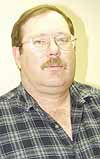| Steven Wilkinson |
Steven Wilkinson of Price served in the United States Army for 13 and a half years. Six months of that was spent fighting in Desert Storm or as it is known today, the Gulf War. Steven was injured in that battle as America led a coalition to remove Suddam Hussein from Kuwait.
Growing up in southern California he is a graduate of Santa Ynez Valley High School, which is near Santa Barbara. He enlisted on his 18th birthday. Prior to Desert Storm he served in several locations on American soil and spent two tours in Germany.
Wilkinson was one of over a half million American troops that were moved into the region beginning in August of 1990. He was sent to an area near the border of Kuwait and Saudi Arabia in October of 1990 and the division began moving north into defensive positions around the middle of December. The war officially began January 17, 1991 and by that time Wilkinson’s unit had arrived in King Khalib Military City in Saudi Arabia.
He was in the first Cavalry division, and they were the heaviest division in the world at that time.
“We knew we were getting close to war,” he says, recalling, “we were issued hand grenades, live ammunition and they conducted final equipment check ups.”
The official word came at 2:45 a.m. January 17 when cruise missiles were fired towards Iraq.
| Steve Wilkinson stands with another soldier in front of an unexploded rocket in the middle of the Iraqi desert during Operation Desert Storm. |
“The skies were filled with aircraft,” he remembers.
Wilkinson said his unit continued moving north and became know as the Deception Force. He explained that their job was to draw the Iraqi units towards them giving the enemy the feeling that the area on the border was where the battle would be fought. In the mean time other units were circling the Iraqi troops. This strategy was used from December to the beginning of the war in January.
While Wilkinson’s company was doing deception attacks in Bradley Fighting Vehicles, which were infantry fighting transports tha can be compared to a light tank, they got hit by a missile and lost two of the machines in the fight. The battle was known as the Ruqi Pocket. His unit lost five soldiers with another seven, including Wilkinson, wounded.
But plans changed and just as Wilkinson’s division was preparing to roll into Baghdad, even though they had broken Suddam’s troops, word of a cease-fire was declared and the war was over.
“We could have disposed of him but we pulled back and now have given him 11 more years to harden his people and further turn them against United States,” he says.
Today as President George W. Bush urges the United Nations to go back into Saudi Arabia and stop Suddam Hussein, Wilkinson shakes his head and says, “We would have had far less casualties if we could have completed our task when we were there in 1991. ”

